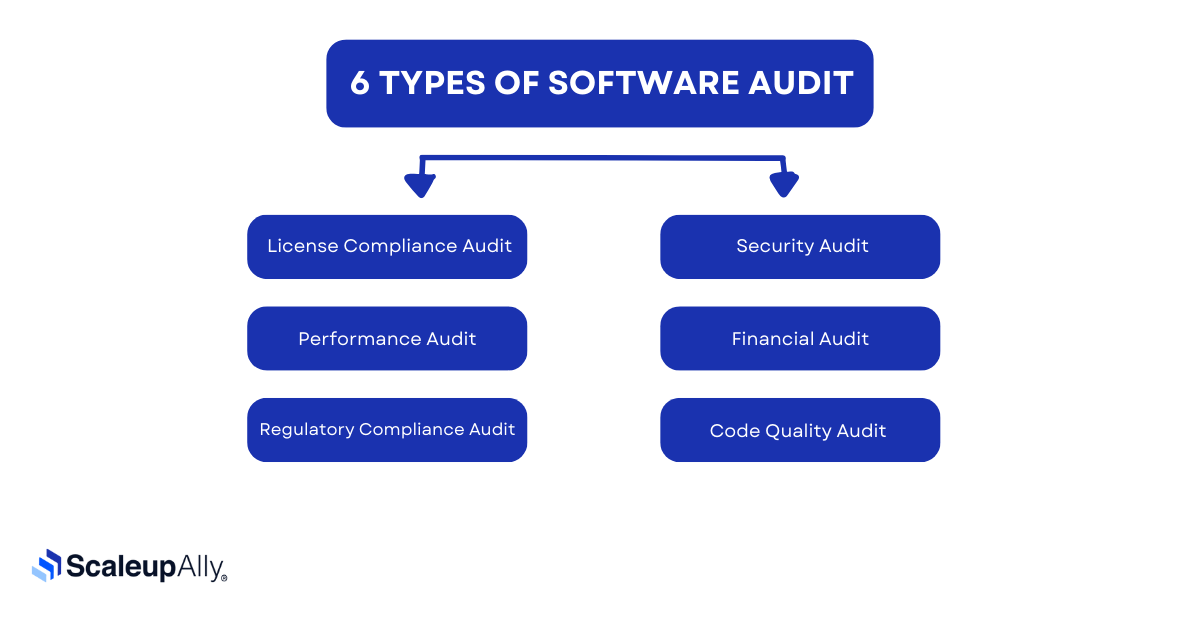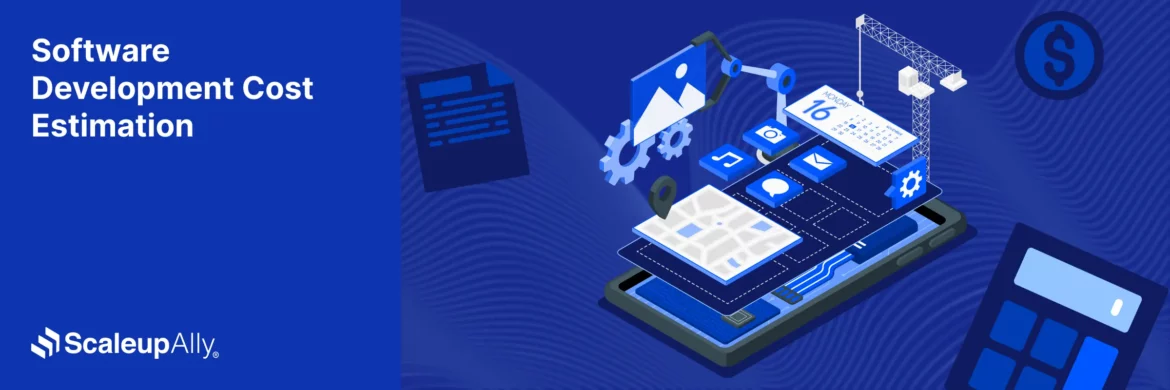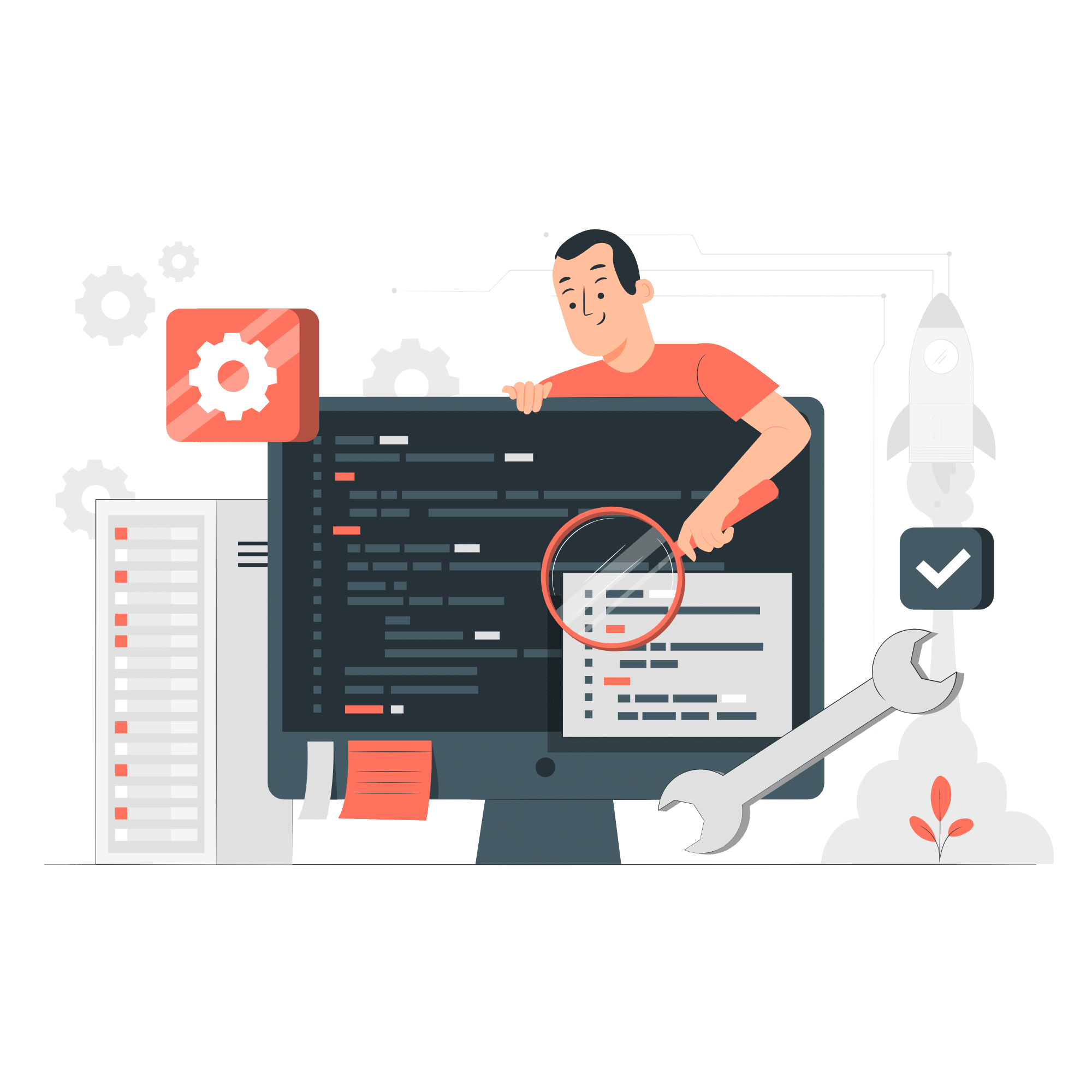![Software Audit: A Complete Guide [2025]](https://scaleupally.io/wp-content/uploads/2024/11/ScaleupAlly-Blog-Post.png)
Software Audit: A Complete Guide [2025]
Suprabhat Sen | November 29, 2024 , 12 min read
Table Of Content
Datawares to Softwares, these digital goods are breaking new ground. Large ambitious organizations often oversee vast networks of information systems and pools of data, ranging from endpoint devices and cloud workloads to APIs, network setups, digital identities, and lines of code.
Numerous security flaws are often present in these organizations at any given time due to the large number of moving components such as human error, and software bugs.
It is not uncommon for these organizations to have some vulnerabilities that may pose risk, and if left unattended, could be exploited by cybercriminals that could directly threaten their critical systems, sensitive data or even organization’s core operations, making it vital to identify and attend to the most dangerous ones before all hell breaks loose.
As digital transformation accelerates, the demand for comprehensive software performance assessment and audits has never been more critical to maintain integrity, reduce costs, and maintain confidence!
Key Takeaways
- A software audit evaluates compliance with software licenses and regulations, security, and efficiency of software assets within an organization.
- Different types of audits focus on licensing, security, performance, or regulatory compliance for any security vulnerability checks.
- Proper preparation and a checklist ensure the audit process is thorough and efficient.
- The market demand for auditing software is skyrocketing as compliance and security become top priorities.
What is a Software Audit?
- What is a Software Audit?
- Why Conduct a Software Audit?
- When to Conduct a Software Audit?
- 6 Types of Software Audit
- How to Perform a Software Audit: Step-by-Step Guide
- Software Audit Checklist
- What to Expect from a Software Audit?
- Common Mistakes to Avoid During a Software Audit
- Concluding Words
- Frequently Asked Questions
A software audit is a thorough scrutiny of an organization’s software usage, license agreements, security standards and legal regulations. It makes an assessment whether the software used by the organization meets the required expectations, consistent with the vision.
Software audits are typically carried out by internal teams or external experts. For organizations to stay worry free, conducting these audits with respect to the legal and optimized software use, minimize unexpected costs, and mitigate risks associated with mismanagement can not be swept under the rug. As businesses rely more on complex software systems, regular audits are necessary to safeguard security.
What does the market say?
The software audit market, valued at around 1 billion dollars (2024) is expected to grow to $3.02 billion by 2032. This explains the expansion driven by growing security needs. With each passing year, there is an increase in adoption of audit management software by organizations of all sizes, and the integration of emerging technologies into audit processes.
As digital ecosystems become more complex, many organizations are also increasingly investing in digital analytics audit processes to ensure that their data usage, analytics tools, and software platforms are secure, compliant, and optimized for performance.
Benefits of a Software Audit:
- Warrant legal compliance with licensing terms.
- Identifies unused or underused software, enabling cost savings.
- Detects security flaws that could lead to data breaches.
- Helps optimize software usage and performance.
A software asset management can also serve as a preventive measure for any IT risk mitigation, avoiding potential issues before they become costly or damaging.
Why Conduct a Software Audit?
We know why! Here are some key reasons to conduct a software audit:
- License Compliance: Without license, company might risk losing business. Hence, to avoid the dreadful, audit helps make sure all the software used by the company is properly licensed. Save from penalties and legal trouble for using unlicensed or pirated software, which can drain the pocket.
- Spot Security Weaknesses: Audits look for security gaps or outdated software that could be vulnerable to cyberattacks. By spotting these risks early, a company can protect sensitive business and customer data from being compromised, and avoid making a dent in the company’s reputation (which has long term repercussions.)
- Find the obsolete: An audit can uncover software you’re paying for but not actually using. This helps cut out unnecessary subscriptions or licenses, freeing up budget.
- Boost Productivity: Inefficiencies delays the workflow, adding to the debt, financial or technical for future to rectify. These become liabilities in no time. These timely audits spot such inefficiencies, which in term lets one fix or replace underperforming tools. As a result, workflows improve which makes things easier for everyone.
- Stay on Top of Regulations: If your business is in a regulated industry (like finance or healthcare), a software audit ascertains that these tools are meeting the required standards, and will keep you at the top.
- Prepare for Growth: These assessments let you be aware of whether your current tools can scale with you or if it’s time to upgrade, replace, or add new software to support future growth.
In short, software audits are a smart way to keep your business running smoothly, securely, while saving money and preparing for what’s next.
When to Conduct a Software Audit?
The timing of a software audit depends on various factors such as business size, industry regulations, and the frequency of software updates. Here are some instances when you should consider conducting a software audit:
- Annually or Bi-Annually: These are regular audits, usually conducted once or twice a year. An annual or bi-annual audit is often a good practice for large organizations with complex software portfolios.
- Before a Software Upgrade or Renewal: If you plan to upgrade or renew any software licenses or services, conducting an audit beforehand helps identify which software is still in use, which licenses need to be renewed, and which can be decommissioned or replaced.
- After Major Business Changes: If your company undergoes significant changes such as mergers, acquisitions, or department restructurings, a software audit warrants that all systems are aligned, properly licensed, and secure during the transition.
- When Expanding or Scaling: The necessary infrastructure to support the growth, while optimizing resources and licenses can only be supported and maintained with timely software auditing.
- Following a Security Breach: If your organization experiences a security breach or other cyber incident, a software audit rescues by identifying gaps in your security measures and all vulnerabilities are addressed.
6 Types of Software Audit

There are several types of software audits, each serving a different purpose. Below are the six main types:
1. License Compliance Audit
Focuses on certifying that the organization uses software in accordance with the terms of the license. The audit checks if the installed software complies with vendor agreements and licensing terms. This helps prevent legal and financial penalties associated with software misuse or overuse.
2. Security Audit
Security assessment focuses on identifying vulnerabilities in software and its environment. It checks whether the software is secure from known security threats, malware, or breaches, and stays up to date on the latest security measures.
3. Performance Audit
Performance audits analyze the effectiveness of software in meeting business objectives. This includes verifying that the software is working properly, addressing performance issues such as system crashes, slowdowns, and inefficiencies in deployment.
4. Financial Audit
Economic analysis analyzes software costs, comparing the costs of software licenses, subscriptions, and services relative to usage. The figures identify areas where businesses can cut costs or optimize their software investments.
5. Regulatory Compliance Audit
This audit checks that the software complies with industry-specific regulations and standards such as GDPR (General Data Protection Regulation) for data privacy, HIPAA for healthcare data, or financial institution compliance so it follows the rules.
6. Code Quality Audit
A code quality audit evaluates the software’s codebase for maintainability, readability, and efficiency. It helps identify areas where the code can be optimized, improved, or refactored for better performance and scalability.
How to Perform a Software Audit: Step-by-Step Guide
Follow the below described steps in order to perform an effective software audit.
STEP 1: Define scope and objectives
Set the right agenda from the start by clearly defining what you want to achieve with the audit. Are you checking for license compliance, performance, security, or all of the above?
STEP 2: Create an Inventory of Software Assets
Compile a complete list of all software used in the organization. Include version number, license information, and user information. Make sure this list is up to date and accurate.
STEP 3: Check License Compliance
Review all software licenses to ascertain compliance with laws and agreements. Make sure the number of installations does not exceed the number of licenses you have purchased, and check for any expired or invalid licenses.
STEP 4: Assess Security Standards
Check the security measures associated with each piece of software to ensure they are compliant with industry security standards. This may include checking for recent manufacturing, updates, and compliance with security measures.
STEP 5: Review License ComplianceReview all software licenses to ensure compliance with laws and agreements. Make sure the number of installations does not exceed the number of licenses you have purchased, and check for any expired or invalid licenses.
STEP 6: Check Software Operation
Check if the software works as expected. Identify and address any problems related to system crashes, slow performance errors.
STEP 7: Report Findings and Recommend Actions
Compile a detailed report with findings and recommendations for action. This may include recommendations for software enhancements, usability, security improvements, or the removal of noncompliant software.
Software Audit Checklist
A comprehensive software audit report checklist is key to ascertaining that every aspect of the audit is completed systematically. Here’s a general checklist for conducting a software audit:
| Audit Area | Key Actions for Software Audit Checklist |
|---|---|
| Inventory of Software | - List all software programs and versions in use. - Record license keys, expiration dates, and renewal terms. |
| License Compliance | - Ensure software usage aligns with licensing agreements - Verify the number of users/installs against license terms |
| Security Audit | - Check for missing security patches and updates - Conduct vulnerability assessments - Ensure antivirus and firewall software are up to date |
| Performance Review | - Evaluate the performance of applications - Check for system inefficiencies or bottlenecks - Optimize software for better performance |
| Cost Evaluation | - Review software licensing and subscription costs - Identify underused software that can be eliminated or consolidated to save costs |
| Regulatory Compliance | - Verify compliance with industry regulations (e.g., GDPR, HIPAA) - Ensure software adheres to data protection and privacy laws |
| Backup and Recovery | - Ensure regular software backups - Test disaster recovery procedures - Verify backup security |
| Findings and Documentation | - Document audit findings - Create a plan to address any compliance, security, or performance issues - Track progress on remediation |
What to Expect from a Software Audit?
When undergoing a software audit, organizations should expect:
| Audit Step | Description |
|---|---|
| Data Collection | - Collect data on software licenses, installed applications, users with access, and proof of licenses. |
| Report of Findings | - Create a detailed report on the audit findings. - Schedule a meeting with the company to discuss issues or concerns. |
| Compliance Plan | - Develop a software compliance plan outlining necessary changes. - Send the plan to management for approval. |
| Corrective Action Plan | - Negotiate a corrective action plan with the company. - Implement the plan once both parties agree on the actions. |
| Training | - Notify relevant personnel of updated compliance policies. - Provide training to staff if necessary to ensure understanding and compliance. |
| Final Audit Report | - Prepare and submit a final audit report summarizing the entire audit process, findings, actions taken, and recommendations. |
Common Mistakes to Avoid During a Software Audit
As a business you should steer clear of the below mistakes while conducting a software audit:
- Incomplete Inventory: Failure to document every piece of software can lead to contradictions and inaccurate conclusions.
- Ignoring Security: Not prioritizing security during the audit can leave vulnerabilities unnoticed, leading to potential breaches.
- Lack of Communication: Not involving key stakeholders or departments in the audit process can lead to incomplete data and unattended issues.
- Lack of Documentation: Not having proper licensing records or proof of purchase for all software can lead to discrepancies and potential legal issues.
- Ignoring Software Updates: Using outdated software without an up-to-date security policy can leave your system vulnerable to attacks and compliant with security standards
- Mismanagement of User Access: Overlooking user permissions or access controls can lead to unauthorized use of software or data breaches.
- Violation of Compliance Requirements: Failure to comply with industry-specific regulations (e.g., GDPR, HIPAA) may result in fines and legal penalties
- Neglecting Software Usage: Not regularly reviewing software usage can result in paying for unused licenses or inefficient applications.
Concluding Words
According to a Gartner report, up to 30% costs are cut down by the organizations that invest in regular software audits. So, these audits do help in cost reduction and efficiency improvements in software.
Great! As a result, it also helps build the confidence that vouches for the stability for potential stakeholders. More trust, more good business scope. By proactively adopting software auditing systems, companies can reduce costs, improve operational efficiency, and make more informed decisions that lead to long-term success.
On a different note, if you happen to look for building a custom application, or business intelligence tools for your business? We do it all. Talk to us today and enjoy a free consultation.
If you’re ready to start your custom software journey, you’ve found the right team. At ScaleupAlly, we’re proud to be innovative problem-solvers, collaborative partners, and business-minded technologists. Our software development services are tailored to meet your unique business needs, ensuring solutions that scale and succeed.
Frequently Asked Questions
Q: How often should a business conduct a software audit?
It is advised to conduct a software audit bi-annually, or at least annually for a robust, safe and optimized performance.
Q: How should you prepare for a software audit?
Create an accurate inventory of software, collect the license details, organize all the relevant documents like legal contracts and compliance records. This will suffice for the initial preparation.
Q: Who does software audits?
Software audits can be conducted by internal IT teams, external auditors, or specialized third-party audit firms with expertise in software licensing, security, and compliance.
Q: How much does a software audit typically cost?
In general, it ranges between US $2000 to US $10,000, and can even go higher depending on the complexity, size of the organization, and the scope of the audit.
References:
Related Blogs

Top 20 Emerging Technologies of 2026
Discover the top 20 emerging technologies of 2026. Explore which innovations are driving change across healthcare, finance, manufacturing, and other crucial industries.
ScaleupAlly Team
Dec 16 ,
9 min read

Software Development Timeline: Phases, Duration & Estimation Guide
Understand the software development timeline with phase durations, key factors, hidden delays, and practical methods to estimate project time.
Suprabhat Sen
Nov 29 ,
16 min read

Software Development Cost Estimation Guide: What’s Included & What Affects the Price
Explore software development cost components, major pricing factors, and practical estimation methods to plan your project accurately from start to finish.
Suprabhat Sen
Nov 29 ,
14 min read



